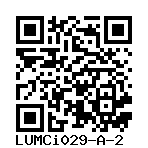IsoLUMC0072iENG p.Met1Val-F5
The cell line is not validated yet.
LUMCi029-A-2
General
Cell Line |
|
| hPSCreg name | LUMCi029-A-2 |
| Cite as: | LUMCi029-A-2 |
| Alternative name(s) |
IsoLUMC0072iENG p.Met1Val-F5
|
| Cell line type | Human induced pluripotent stem cell (hiPSC) |
| Similar lines | No similar lines found. |
| Last update | 14th October 2025 |
| User feedback | |
Provider |
|
| Generator | Leiden University Medical Center (LUMC) |
| Owner | Leiden University Medical Center (LUMC) |
| Distributors | |
| Derivation country | Netherlands |
External Databases |
|
| BioSamples | SAMEA120356029 |
General Information |
|
| * Is the cell line readily obtainable for third parties? |
No |
| Subclone of | |
Donor Information
General Donor Information |
|
| Sex | male |
| Ethnicity | unknown |
Phenotype and Disease related information (Donor) |
|
| Diseases | No disease was diagnosed.
|
| Family history | N/A |
| Is the medical history available upon request? | No |
| Is clinical information available? | No |
Other Genotyping (Donor) |
|
| Is there genome-wide genotyping or functional data available? |
No
|
Donor Relations |
|
| Other cell lines of this donor | |
External Databases (Donor) |
|
| BioSamples | SAMEA6673739 |
Ethics
Also have a look at the ethics information for the parental line
LUMCi029-A
.
| Is there an MTA available for the cell line? | No |
| For generation of the cell line, who was the supplier of any recombined DNA vectors or commercial kits used? | |
| Are you aware of any constraints on the use or distribution of the cell line from the owner or any parties identified in the query above? | Yes |
| Constraints for use or distribution | waste material, no inform consent |
hIPSC Derivation
General |
|
|
The source cell information can be found in the parental cell line
LUMCi029-A.
|
|
Reprogramming method |
|
| Vector type | Non-integrating |
| Vector | RNA |
| Genes | |
| Is reprogramming vector detectable? |
Unknown |
Vector free reprogramming |
|
Other |
|
| Selection criteria for clones | morphology |
| Derived under xeno-free conditions |
No |
| Derived under GMP? |
No |
| Available as clinical grade? |
No |
Culture Conditions
| Surface coating | Vitronectin |
| Feeder cells |
No |
| Passage method |
Enzyme-free cell dissociation
Gentle Cell Dissociation Reagent
|
| O2 Concentration | 20 % |
| CO2 Concentration | 5 % |
| Medium |
Other medium:
Base medium: StemFlex
Main protein source: StemFlex Supplement Serum concentration: % |
| Has Rock inhibitor (Y27632) been used at passage previously with this cell line? | Yes |
| Has Rock inhibitor (Y27632) been used at cryo previously with this cell line? | No |
| Has Rock inhibitor (Y27632) been used at thaw previously with this cell line? | Yes |
Characterisation
Analysis of Undifferentiated Cells
| Marker | Expressed | Immunostaining | RT-PCR | Flow Cytometry | Enzymatic Assay | Expression Profiles |
Differentiation Potency
In vitro directed differentiation
In vitro directed differentiation
Microbiology / Virus Screening |
|
| Mycoplasma | Negative |
Genotyping
Karyotyping (Cell Line) |
|
| Has the cell line karyotype been analysed? |
Yes
normal
Passage number: 29
Karyotyping method:
G-Banding
|
Other Genotyping (Cell Line) |
|
Genetic Modification
| Disease/phenotype related modifications |
|
| Genetic modifications not related to a disease |
|


Login to share your feedback, experiences or results with the research community.